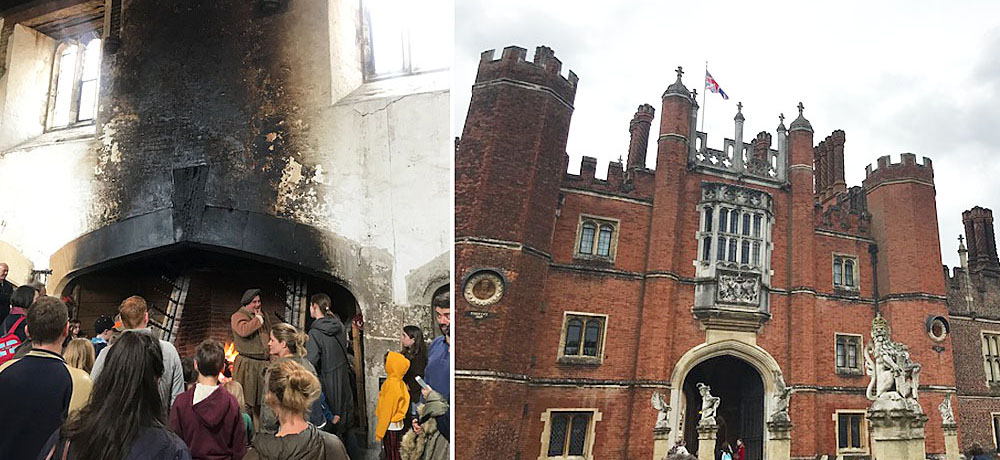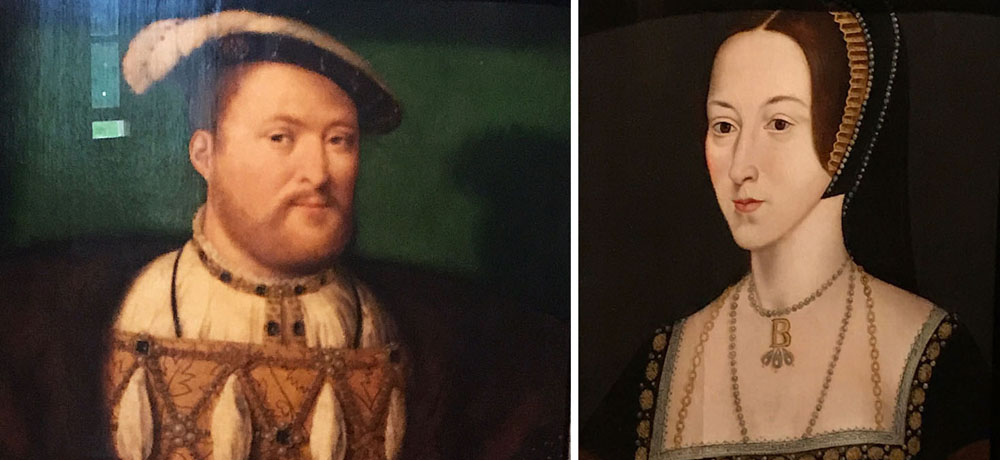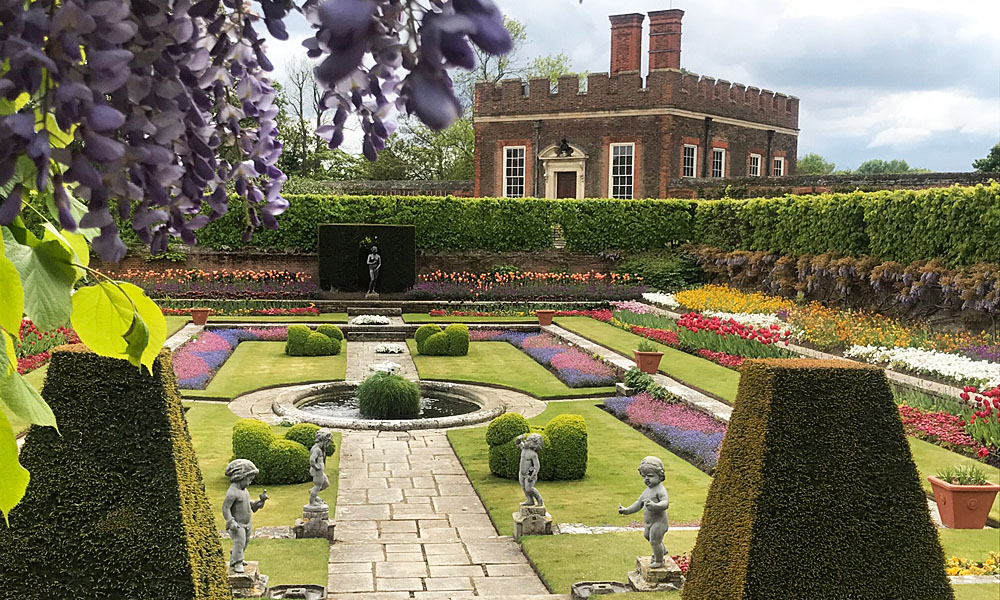|
Blog posts and photos by faculty on the London site visit to the London & Florence: Arts in Context program |
Visiting Hampton Court Palace
Post by Amy Weldon, Associate Professor of English, Luther College
Like everyone else in the Wolf Hall era, and like many bookish lit-and-history kids, I’ve got a long imaginative history with Henry VIII and his wives. So I was primed for a visit to the Thames-side palace of Hampton Court, which Henry VIII appropriated from his disgraced cardinal, Thomas Wolsey, son of a butcher who didn’t sever a king from his unwanted first wife quickly enough.
Read posts about:
• Hampstead and Highgate
• Student Flats and the Tube
• Romeo and Juliet at the Globe Theatre
• Lunch at Ottolenghi
Divorced, beheaded, died, divorced, beheaded, survived: a father was trying to recite the familiar mnemonic to his little boy as we entered, and a recorded voice (one of several recorded sounds) intoned it in an angry-female-ghost-like whisper as we passed through a hall with a soaring staircase. The nearby poster for a “Barmy Britain” children’s history tour (“Horrible Histories: Live on Stage”) featured a brawny cartoon Henry (“I’ve got the ax-factor”) arguing with a cartoon Queen Victoria (“You don’t empress me!”) Bring in the punters, y’all.
Learn more about London & Florence: Arts in Context
Yet in the company of Professor Andrew Kennedy and the students taking his London as Visual Text course today, I was prompted anew to consider how the past is remembered and preserved, and why. In an era when (as The Onion famously satirized) everything in the world seems to be under copyright or branded or predigested or otherwise presented to slide easily down our brain’s gullet without touching the sides — even history, or “heritage” — is it possible to access some trace of a past, or some experience of it, or some emotion about it, that could be called real? Authentic? Meaningful? As a writer whose practice and pedagogy are built on observation of and responsibility to the world beyond your own head (to borrow Matthew Crawford), my own short answer is yes.
“…Charles I escaped down to the same Thames at the foot of the same gardens where I walked today…”
This is where I admit cheerfully how naïve, even sort of Stendahl-syndrome-risking, willfully naïve, this could sound. But for writers, observed detail of place and people — which does provide some historical constants, because the human body and its needs and the sensory language that speaks to us over time provide some constants — is a way to imagine ourselves into other lives and places, including those inscribed on a place over time in a variety of hands. It’s the skill without which our craft (or sullen art) literally doesn’t work.
For me, this works best when the interpretive layering around a “heritage” site recedes a little and we can focus on observed detail present to our senses as it could have been present to the senses of those who inhabited the space before. The blackened layer of creosote built up all the way to the ceiling on the whitewashed wall above the massive fireplace in the kitchens, where a turning-boy could start and work his way up to a cook’s position (making fourpence a year, likely sent home to his family since all his own food, lodging, and clothing would be provided for.) The heat of candles in a chapel, lit for prayer, the intermittent light through the windows inscribed (as most things at Hampton Court are inscribed, lest anyone forget its kingly owner, Dieu et Mon Droit; the Tudors, I learned today, wrote capital N’s backwards, which can be seen everywhere in that motto.) The faint urinous reek that still clings to the king’s toilet in the 17th-century wing; bodies have their own humble needs, matter-of-fact and inescapable. The chill that shadowed these high-ceilinged rooms on a day that alternated between rain and cloud and doubtful sun and eventually worked itself out into a radiant afternoon. Other humans in other times and places were as present to themselves moment to moment as we are, walking the world in flesh draped with cloth, navigating political and social change that only seems neat and settled to us (talk about naïve) because we know how it ends. They didn’t. They couldn’t have. Neither can we.

Join this up with historical and social knowledge and you have an admittedly novelistic but, every instinct tells me, useful way toward approaching the past. Take clothes, for example. Seventeenth-century dresses and coats made (kind of bizarrely, but perhaps with a certain memento mori appropriateness) of paper stand around in William of Orange’s formal rooms. Think of it: in a time when hot baths were a much bigger production than now, and passing from overheated rooms to chilly outdoors and back might leave one sweating under layers of clothes that might not have often been cleaned, then cooling off quickly, and when getting ahead in one’s career meant dressing properly anyway, you’d have a lot of standing around in formal clothes. Standing at the morning levee, when the king receives VIPS in his bedchamber. Standing around watching shifting circles of nobles and mistresses and who’s-in-who’s-out playing cards. Standing at attention as the Royal Presence, to whom you might not dare to raise your eyes, lumbers past.
“…I argued with myself about my own novelistic imagining tendencies: am I just making up what I want to see? Possibly.”
Hampton Court is a labyrinthine place. Who knows if even the most experienced servant, or courtier, ever really learned their way around all of it? And considering the human stories and the human variables that played themselves out in this space — Charles I escaped down to the same Thames at the foot of the same gardens where I walked today — you can feel yourself invited close to something every instinct tells you is real, a human presence under the exsanguinating layers of dates and information, which will exsanguinate history if the story is left out. That’s one of many reasons I think Hilary Mantel gets the Tudors and Thomas Cromwell and John Hunter (in The Giant O’Brien, the novel that introduced me to him and to Charles Byrne, whom we’ll visit in the Hunterian tomorrow) deeply right. Story has an intelligence of its own, which hones in on emotional truth.
Listening to Andrew Kennedy talk with the students about the choices that go into presentation of material at “heritage” sites, I argued with myself about my own novelistic imagining tendencies: am I just making up what I want to see? Possibly. Is what I’m doing really any different than the “Barmy Britain” floor show? Do I have a right to judge? That’s debatable, but, of course, I’d argue yes.
 Portraits of Henry VIII and Ann Boleyn at Hampton Court Palace.
Portraits of Henry VIII and Ann Boleyn at Hampton Court Palace.
Although any approach to the past is perhaps gauzed by layers of theory or philosophy or just straight-up distance and unknowingness and time, there are better or worse ways to do history, and to memorialize it. On my first visit to the Tower of London in 2000, I remember seeing a plain — and, yes, chilling — wooden block at the site in the corner of the yard where Anne Boleyn was beheaded. Returning 13 years later with my students, I yelped in shock to find there what appeared to be a giant plexiglass pillow suspended over giant glass table — a post-Princess-Diana-ish bit of tone-deaf naffdom that speaks more of confused romanticism about doomed “princesses” than about the reality of a woman ushered to the block because she had become inconvenient for a man unused to hearing the word no. Dare I use the word “reality” amid so many interpretative statements? Well, I have some evidence, but, yeah. I’m interpreting. We all are. Maybe the best we can hope for is just to have better evidence. But we have to try.

Because why does it matter? Why do the interpretive officers of Hampton Court try so hard to get the right balance of text and image for our distractible age, working so diligently at hooking the wandering eyeballs of all the families and students who wander through? Because — and I believe this deeply and defiantly — it is good for human beings to remember that reality is not, and has never been, limited to us and our present concerns. We can resist simplistic interpretations with better ones (like reaching past often-twee American Anglophilia by learning what “keep calm and carry on” merchandise is really about.) We can learn from great lecturers like Andrew Kennedy about how the medieval features of Hampton Court show that the Tudors were “telling themselves a story” about a glamorous, glorious past, too: is a moat that doesn’t go all the way around a castle really there for defense, or just for decoration? But we must keep reaching toward what might be known or at the very least realistically, responsibly, and with some nuance imagined from the past, from other worlds than those we and those like us have known right at this minute.
It’s why I read, write, and teach. It’s what I do. It’s why the tourist managers of Hampton Court put on “Barmy Britain” in the first place. Maybe, if people come close enough to the past, they might snag on some human texture, some surface of fact or experience that just may surprise us with its authenticity. We can remind ourselves that there is no safe harbor of “history” where politics were ever less furious, life was ever less confusing and scary, or humanity was ever less baffling and weirdly marvelous than it seems to us. Underneath the tat and swag and gift-shop scrum may still be something real.










